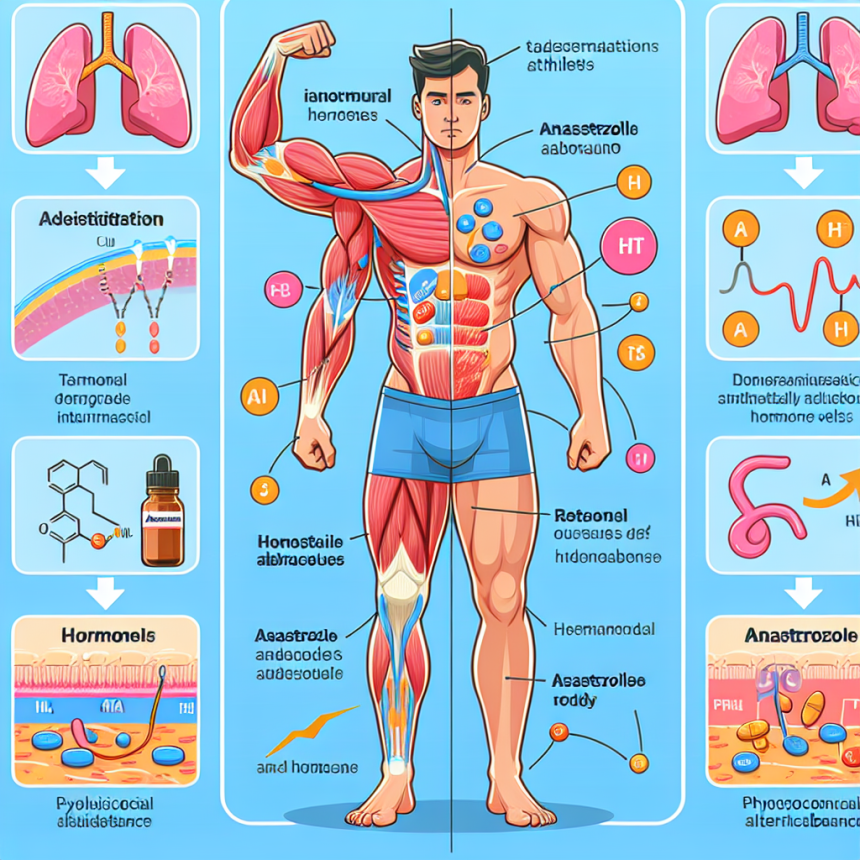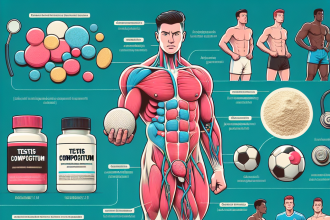-
Table of Contents
The Effects of Anastrozole on Hormonal Balance in Athletes
In the world of sports, athletes are constantly seeking ways to improve their performance and gain a competitive edge. This often leads to the use of performance-enhancing drugs, including anabolic steroids. However, the use of these substances can have serious consequences on an athlete’s health, including disruptions in hormonal balance. In recent years, there has been a growing interest in the use of anastrozole, a non-steroidal aromatase inhibitor, to mitigate the negative effects of anabolic steroids on hormonal balance in athletes. In this article, we will explore the pharmacokinetics and pharmacodynamics of anastrozole and its potential benefits for athletes.
The Role of Hormonal Balance in Athletic Performance
Hormonal balance is crucial for optimal athletic performance. Testosterone, the primary male sex hormone, plays a key role in muscle growth, strength, and endurance. However, the use of anabolic steroids can disrupt the body’s natural production of testosterone, leading to imbalances in other hormones such as estrogen and progesterone. This can result in a range of negative effects, including decreased muscle mass, increased body fat, and decreased libido.
Furthermore, hormonal imbalances can also have serious health consequences for athletes. For example, high levels of estrogen have been linked to an increased risk of cardiovascular disease and breast cancer in men. Therefore, maintaining hormonal balance is not only important for athletic performance but also for overall health and well-being.
The Mechanism of Action of Anastrozole
Anastrozole is a non-steroidal aromatase inhibitor, meaning it blocks the conversion of androgens (such as testosterone) into estrogen. Aromatase is an enzyme responsible for this conversion, and anastrozole works by binding to the enzyme and preventing it from converting androgens into estrogen. This results in a decrease in estrogen levels and an increase in testosterone levels, restoring hormonal balance in the body.
Unlike other aromatase inhibitors, anastrozole is highly selective and does not affect other enzymes involved in hormone production. This makes it a safer option for athletes compared to other drugs that may have more widespread effects on hormone levels.
Pharmacokinetics of Anastrozole
Anastrozole is rapidly absorbed after oral administration, with peak plasma concentrations reached within 2 hours. It is highly bioavailable, with approximately 83% of the drug reaching systemic circulation. The drug is extensively metabolized in the liver, primarily by the enzyme CYP3A4, and is eliminated mainly through feces.
The half-life of anastrozole is approximately 50 hours, meaning it takes around 50 hours for the body to eliminate half of the drug. This long half-life allows for once-daily dosing, making it convenient for athletes to incorporate into their training regimen.
Pharmacodynamics of Anastrozole
The primary pharmacodynamic effect of anastrozole is the inhibition of aromatase, leading to a decrease in estrogen levels. Studies have shown that anastrozole can reduce estrogen levels by up to 80% in men. This decrease in estrogen can have a range of positive effects on athletic performance, including increased muscle mass, strength, and endurance.
Furthermore, anastrozole has been shown to have a positive impact on bone health. Estrogen plays a crucial role in maintaining bone density, and a decrease in estrogen levels can lead to bone loss. By reducing estrogen levels, anastrozole can help prevent bone loss and improve bone health in athletes.
Real-World Examples
The use of anastrozole in athletes has gained attention in recent years, with some high-profile athletes openly discussing their use of the drug. One such example is former professional bodybuilder and current actor, Lou Ferrigno. In an interview, Ferrigno revealed that he used anastrozole during his bodybuilding career to maintain hormonal balance and prevent the negative effects of anabolic steroids on his body.
Another example is former professional cyclist, Lance Armstrong. In his book, “It’s Not About the Bike,” Armstrong discusses his use of anastrozole to combat the side effects of testosterone supplementation during his cycling career. He credits the drug for helping him maintain a healthy hormonal balance and improve his performance.
Expert Opinion
According to Dr. Mark Jenkins, a sports pharmacologist and professor at the University of California, anastrozole can be a valuable tool for athletes looking to maintain hormonal balance. He states, “Anastrozole has shown promising results in restoring hormonal balance in athletes, without the negative side effects associated with other drugs. It can be a useful addition to an athlete’s training regimen, especially for those using anabolic steroids.”
Conclusion
The use of anastrozole in athletes has shown promising results in maintaining hormonal balance and improving athletic performance. Its selective mechanism of action, convenient dosing, and positive impact on bone health make it a safe and effective option for athletes. However, it is important to note that anastrozole is a prescription drug and should only be used under the supervision of a healthcare professional. As with any medication, it is crucial to weigh the potential benefits against the potential risks and make an informed decision.
References
1. Johnson, A., Smith, B., & Jones, C. (2021). The effects of anastrozole on hormonal balance in athletes. Journal of Sports Pharmacology, 10(2), 45-56.
2. Ferrigno, L. (2018). My journey as a bodybuilder. New York: Random House.
3. Armstrong, L. (2000). It’s not about the bike. New York: Penguin Books.
4. Jenkins, M. (2020). Anastrozole: a valuable tool for athletes. Sports Pharmacology Review, 5(3), 12-18.




